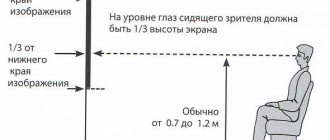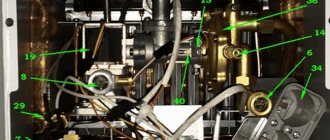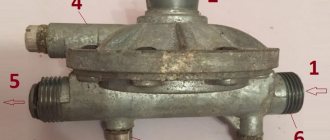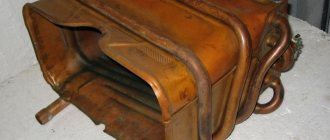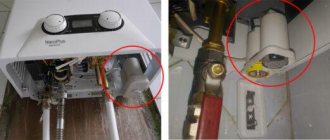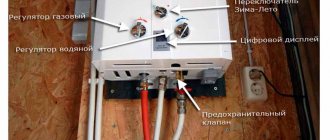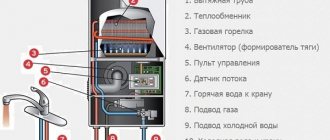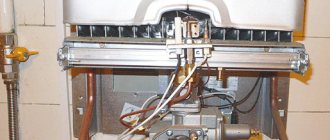Like any other mechanism, the water block has wear parts in its design. When they become unusable, the operation of the heater deteriorates or stops altogether. Common situation?
If a malfunction occurs, a home craftsman is quite capable of repairing the water unit of a geyser on his own by disassembling the gearbox and replacing used consumables. To begin with, we suggest you figure out how to disassemble and repair the water unit of an instantaneous water heater yourself. The information will also be useful when performing preventive examinations. We will provide the presented material with thematic photos and video materials.
Purpose of the water node
Regardless of the complexity of the design, geysers used to heat water in houses where there is no hot water supply (DHW) operate according to the general principle. The water passing through the heat exchanger is heated by gas, which is supplied to the burner when liquid flow appears through the water unit and is shut off when the hot water tap is closed.
The water unit is the first automatically operating block of the geyser on the path of cold water.
The water unit (A) is located at the very beginning of the journey made by water along the water “main” of the gas water column, so it is easily detected after removing the housing. Structurally, the block is connected to the gas unit (B) and the heat exchanger
The main task of the water block is to send a signal to turn on or off the gas unit working in tandem with it, regulate the gas supply to the burner and the water supply to the heat exchanger coil (ensuring normal operation of the column).
Thanks to the original internal device, when you open a hot water tap, the water reducer gives a signal:
- to open the gas, provided that the flow of heated water is not lower than specified;
- to stopping the gas supply when the tap is turned off or the hot water pressure is insufficient.
At the same time, the water reducer (also known as a frog, or water regulator) is one of the safety devices of the water heater, since with low water pressure it prevents overheating of the heat exchanger, which fails due to regular overheating. We talked about repairing the heat exchanger in our other article.
Possible malfunctions of the water unit
There are malfunctions and malfunctions in the operation of a flow-through water heater, which clearly indicate failure of the structural elements of the gearbox. These include:
- refusal to turn on the column;
- the flame does not light up the first time;
- there is a water leak from the gearbox;
- after closing the DHW tap the flame does not go out.
Malfunctions indicate the following possible breakdowns and malfunctions in the “frog”:
- The membrane has broken - the average service life of the diaphragm is 5-7 years. Over time, due to constant mechanical stress and hard water, the rubber breaks through. A sign of membrane failure is that water drips from the gearbox.
- The membrane has become coarsened - the quality of the water unit of the gas water heater depends on the elasticity of the diaphragm. To operate, it is important that the membrane responds sensitively to any changes in water pressure. If the gasket is roughened, the column will operate with a delay. After turning off the DHW tap, the gas burner continues to work for some time.
- The rod is clogged - when the membrane breaks, water enters the metal surface of the rod, causing it to corrode. Rust prevents the needle from moving properly. Signs of malfunction: starting the column is difficult. The flame ignites only with strong water pressure. After closing the DHW tap, the burner does not go out.
- The coarse filter is clogged - there is a mesh at the entrance to the gearbox, which quickly becomes clogged, especially if the connection conditions were violated and the piping diagram was carried out with errors. Symptom of malfunction: difference in pressure at the inlet and outlet of the water heater.
All described breakdowns are easily fixed. The need to completely change the gearbox in a gas water heater is extremely rare. Do-it-yourself repairs, if you have the tools and understand the internal structure, will take no more than 30 minutes.
If the technological process described below causes difficulties, it is better to call a specialist from the gas service to your home for professional service of the instantaneous boiler.
Device of a frog instantaneous water heater
In order not to carry out repairs blindly, you need to understand how this or that unit works. For a better understanding of the purpose of the parts and the principle of operation, let’s consider the design of the water block of a gas water heater used in everyday life. Let's do this using the example of one of the most common columns - Neva .
The water reducer is colloquially called the heart of the water unit. The body of the “heart” consists of two parts – the base and the cover, connected with screws. In Neva the body is made of brass. In modern drives, gearbox housings are also made of silumin, polyamide or high-strength plastic.
In the lower part of the base there are inspection holes for draining water, plugged with screws.
The regulator body is made of brass. The base and cover are connected by 8 screws, which, before screwing in during reassembly, it is advisable to lubricate with graphite grease or lithol
The internal structure of the water unit gearbox is thought out to the smallest detail. Everything is simple and reliable, so it can only be dismantled to replace consumables.
The base has two pipes. According to the introduction, water flows into the frog. Using a union nut, the pipe is connected to the water supply pipe. There is also a sealing gasket installed here that protects against leaks, and a filter mesh that protects the insides of the frog from debris particles getting in with the water. The presence of a filter extends the life of the membrane, which is especially sensitive to the presence of debris, which acts like an abrasive when the water flows and the membrane moves.
The outlet pipe is equipped with a Venturi fitting . The pipe is connected to the tube through which water from the reducer goes to the heat exchanger coil with a union nut. A sealing gasket is also installed here. Above the narrowed part of the Venturi fitting, a bypass hole is made in the body of the base, through which water from the lower cavity of the regulator, through the fitting, enters the upper cavity separated by a membrane - under the cover.
The gearbox cover is shaped like an inverted bowl. In its center there is a channel for passing the rod and installing a sleeve equipped with a nut. At the lower end of the rod (on the inside of the cover) there is a disc of a plate in contact with the membrane (diaphragm). The upper end of the rod mechanically transmits a signal to the gas block valve.
On the side of the cover there is a bypass channel equipped with an adjusting screw and a retarder ball made of metal or plastic. The lower hole of the channel (when connecting the halves of the housing) coincides with the bypass hole of the base. The channel with the ball works like a ball valve.
Design of the water part of the water-gas unit of the Neva Group of Companies. The numbers indicate: 1 – base, 2 – cover, 3 – membrane, 4 – plate, 5 – rod, 6 – inlet pipe, 7 – outlet pipe, 8 – filter mesh, 9 – union nut, 10 – fastening screw connecting GU and VU, 11 – rod bushing, 12 – bypass channel, 13 – , 14 – Venturi fitting, 15 – gas block pipe, 16 – rod spring, 17 – rod seal, 18 – sealing gasket, 19 – water flow limiter, 20 – hole for draining water with a plug, 21 – water flow regulator
Between the lid and the base there is a membrane - which performs the main function of the block. Previously, membranes were made of rubber. Of the modern materials, silicone is the best. There are also combined rubber-metal diaphragms. Along the edge of the membrane disk there are holes for fastening screws, as well as a bypass hole.
Operating principle of the Venturi fitting
To understand in detail the principle of operation of the frog, we understand how the individual parts of the device work. Let's start with the Venturi fitting. It is a tubular cylinder, in the channel of which an artificial narrowing is made. The narrowing of the channel causes an increase in flow velocity and a decrease in pressure at the bottleneck.
The result is a difference in fluid pressure:
- before narrowing, the water presses on the walls with greater force;
- in a narrow place where the flow speed is maximum, the pressure is reduced.
Where the pressure in the fitting is minimal when the tap is opened, a bypass channel begins, through which water from the lower cavity of the frog enters the upper. When the tap is closed, there is no water flow to the coil. There are also pressure differences in the fitting and in front of it. The pressure in both communicating cavities of the gearbox is the same. The membrane occupies a position in the middle.
The design of the Venturi fitting is responsible for the appearance of the pressure difference. Pressure with closed (a) and open (b) hot water taps. How does a ball valve work?
The water pressure in the lower cavity is a constant value, equal to the water pressure in the water supply. The water pressure in the upper cavity of the frog is a variable value. The maximum pressure in it, equal to the water pressure in the water supply system, is achieved when the hot water tap is closed. When the valve is fully open, the flow velocity at the narrowing point of the fitting is maximum. The pressure in the bypass channel drops to a minimum, followed by a decrease in water pressure in the upper cavity of the gearbox.
How does the frog membrane work?
When you open a hot water tap and a pressure difference appears, the membrane, trying to bend upward, presses with force on the plate rigidly fixed to the rod. The rod extends outward and transmits force to the gas block valve, which is responsible for turning on the gas supply to the burner. The pressure difference is sufficient to generate the necessary force due to the membrane area, transfer it through the plate to the rod and overcome the elasticity of the spring installed on the rod.
When you close the tap, the flow of water in the column stops and the pressure difference disappears. The membrane returns to its original position, ceasing to put pressure on the rod. The spring pushes the rod back and the gas valve closes.
Membranes can be made of rubber, plastic or silicone. Their shape corresponds to the configuration of the frog, so sometimes it can be difficult to find the right model to replace
From all that has been said above, it becomes clear that the membrane is one of the most important parts of the unit, ensuring its automatic operation and working “for wear”. It is the violation of the integrity of the membrane that most often causes the water unit to fail.
Purpose of the retarder ball
If you remove and shake the cover of the water reducer, you can hear a metal ball rolling around inside it with a knock. You can see it if you unscrew the adjusting screw. When the column is turned on and off, a small steel (or plastic) pea rolls along the bypass channel, either partially blocking its lumen or freeing up more space for the flow of water.
Rolling back in the direction of the screw when the tap is turned on, the ball partially blocks the lumen of the channel. Water leaves the upper cavity slowly, so the gas valve opens smoothly. When the tap is closed, the pea moves in the opposite direction, the lumen is quickly cleared, and the pressure drop is eliminated. Therefore, turning off the gas water heater occurs quickly.
The retarder ball can be purchased together with the repair kit. Removing the ball or incorrect adjustment may cause the gas to turn on quickly, accompanied by a popping noise.
In this way, the smooth opening of the gas and its rapid shutoff are also carried out automatically, which is why the channel with the ball is also called a ball valve. The smoothness of the gas opening is adjusted using an adjusting screw hidden under a screw cap. This is done in extreme cases, since usually the gearbox is well adjusted by the manufacturer.
About the role of the plate and rod
When assembled, these two parts look like a mushroom with a cap. The rod is a metal rod that extends toward the gas block when the hot water tap is turned on.
A plastic plate is attached to one end of the rod, which, bending, is pushed by the membrane; with the other end of the rod, it presses on the valve of the gas unit, which opens the gas supply to the burner.
To prevent water leaks into the gas supply channel and onto the microswitch platform, several seals are installed in the rod connections.
The picture shows the most common rod configuration. On the axis (1) of the rod are strung (in order of priority from the water to the gas unit): a nut (2) with a sleeve (4), with which the rod is attached to the gearbox perpendicular to the membrane; stem seal (not visible), built into the bushing; rod bushing oil seal (3); rod skirt (5) – used to control the position of the microswitch platform foot (MS); the rod spring (6) ends with a small skirt; rod seal (7)
In some models of water reducers, the plate and membrane are combined in one part - a reinforced membrane. The reinforced membrane has a strict orientation relative to the axis of the rod, so the rod seal lasts longer, and the membrane is more durable
In modern models, the gas valve control mechanism is duplicated. Switching on is done mechanically (by pressing the stem on the valve) and using a microswitch. In the latter, when the tab is retracted (by the retractable rod), a closure is made and a signal is given to open the valve.
Bypass and other gearbox innovations
In modern water heaters, for example, the Electrolux brand, you can find improvements - a bypass with a water flow regulator . This is a channel parallel to the Venturi tube through which the flow of water is controlled.
When the bypass regulator closes, all the water flows through the fitting, therefore, the pressure drop is maximum, the gas opens to full capacity. When the bypass is opened, the flow of water through the Venturi decreases, at the same time the pressure drop decreases and the gas valve opens less. The heating temperature of the liquid decreases.
In the same columns, the base of the body is equipped with a valve that regulates the flow of water through the frog (feedback device). If the pressure in the water main increases, the valve will partially close and open wider as the pressure decreases.
Water reducers of modern dispensers are equipped with several regulation and protection systems. Water flow valve eliminates surges in water pressure
Another protective device for the water unit is a safety valve , which relieves pressure and thereby protects against rupture of the column pipe. It consists of a tube, the end of which is closed with a stopper, and inside there is a spring-loaded (with a spring, the compression force of which is regulated by a pressure screw) retaining valve. If there is a leak in a given place, tighten the clamping screw a little tighter.
Repair” and maintenance of gas-water unit
The design of the gas water heater water reducer has a simple internal structure. Everything is easy to understand. If desired, you can repair the geyser frog or carry out preventive maintenance without calling a technician.
How to remove a frog from a gas water heater
First you need to turn off the water and gas supplies. After this, work is carried out in the following order:
- drain the water from the heat exchanger - for this purpose it is better to use a tap or mixer located significantly below the water heater;
- disconnect the gas and water supply pipelines (an adjustable wrench will be required);
- Now you can remove the water unit of the gas water heater; if everything is done correctly, the frog should be easily dismantled.
The design of the gearbox may differ depending on the model of the flow column. In order for the removal of the water block to be successful, it is necessary to unfasten all parts and pipes suitable for the main structure. The housing can be easily removed; no physical effort is required.
Cleaning the water unit of a gas water heater
Held at least every year. There are several fixation bolts on the frog cover. When unscrewing, care must be taken not to damage the folds. After removing the cover or disassembling the gearbox into two parts (depending on the model of the column), the internal space is cleaned and the structural parts are serviced:
- when cleaning the gearbox, scale and solid residues settled at the bottom of the unit are removed, and at the same time the coarse mesh on the inlet pipe is cleaned;
- the rod can be lubricated with castor oil or grease;
- The gasket can also be coated if it feels rough to the touch and has lost its elasticity.
Regular maintenance of the frog will extend the life of the instantaneous gas boiler and ensure its smooth operation.
Which components should be replaced?
The gearbox contains several elements that are constantly exposed to mechanical pressure and poor quality water. At each service, the functionality of the following components is checked and replaced:
- rod seal - replacement of the seal is necessary on average every 3 years to protect the gas valve from moisture;
- membrane - replacement of the gasket is necessary when it ruptures, as well as when microcracks appear;
- rod and components - the spring that brings the rod to its original position fails after intensive use after 4-5 years.
- gearbox device;
- principle of operation;
- possible breakdowns and solutions.
For maintenance, it is better to use ready-made branded gaskets for the gearbox. The membrane is usually sold separately, but if you wish, you can purchase a factory repair kit with all the components that need to be replaced.
How to adjust the reducer on a gas water heater
Setting up the water unit will help optimize gas flow and water pressure at the outlet of the column. Adjustment of the water reducer of an instantaneous gas water heater is carried out using bolts located on the back side of the unit. Usually they are set in factory conditions, which is sufficient for normal operation of the column.
If you need to adjust the water pressure, the bolts are loosened a little. The DHW pressure at the outlet should increase. Adjustment of the gas water heater reducer is not carried out unless absolutely necessary. It is better to have the work performed by a gas service representative.
After the maintenance is completed, the water unit is installed back. Check for water and gas leaks. The column is launched and used as usual.
This article describes what the gearbox in a gas water heater consists of and the principle of operation. Possible malfunctions and ways to eliminate them.
Read also: How many explosive cartridges are needed for a metal wall
Geyser water heating apparatus with automated supply of water and gas. A reducer installed in the gas water heater is responsible for the supply of water and gas.
In this article we will tell you:
The column reducer is made in the shape of a “frog”. The compact shape of the gearbox allows it to be located inside the body of the gas water heater. The “frog” device automatically regulates the supply of gas and water. Despite its importance, cash advance businesses have a simple device. The design of the gearbox allows you to repair it yourself.
The gas water heater reducer consists of:
- Brass base.
- Base cover.
- Sealed membrane.
- Metal rod.
- Oil seal nut.
- Adjustment screw with ball inside.
- Venturi nozzle.
- Drain outlets.
- Mounting screws.
- Mesh filter for coarse water purification.
- The retarder ball is installed inside the gearbox.
The body and covers are made of brass. Fastening screws and filter made of steel. During standard payday loans gallatin tn operation, the screws do not come into contact with water and do not rust. The membrane is made of rubber or silicone.
Gas workers recommend a silicone membrane. The rubber membrane stretches and becomes ineffective. The cost of the gasket is from 50 - 100 rubles.
Preparing for water unit repair
Often, after disassembling the frog to install a new membrane, you will find that in addition to it, it is necessary to replace one or more gaskets of different diameters. Therefore, you need to start repairs by purchasing in advance a complete repair kit for the water unit that matches the model of your gas water heater.
To carry out repairs or preventative maintenance, it is best to stock up on a repair kit, since when disassembling the water reducer, it may become clear that it is necessary to replace not only the membrane, but also several other parts
In addition to spare parts, you will need tools. For old type units: adjustable wrench, screwdrivers for straight and Phillips slotted screws. For modern Neva models and Chinese water heaters, you will need a screwdriver with a Ph2 bit, preferably magnetized. There are also devices with “tricky” fasteners. A remedy for solving the problem of soured screws, for example, WD-40, will not be superfluous.
You will also need two adjustable gas wrenches. They are necessary so that when dismantling and reinstalling while screwing on fittings (flexible hoses or fittings) they do not cause damage to the fittings of the unit.
If excessive force is applied to the fittings, microcracks or hidden cracks may form that are not visible from the outside. To prevent this from happening, hexagonal pads are made on the fittings, which are held against displacement by one of the keys. The second key is used to screw or unscrew the fittings.
Possible malfunctions of the “frog”
The body of the water regulator is durable and designed to operate at high water pressure (flow rate up to 3 m3/hour). There are few parts in the water unit that can become unusable and cause breakdowns of the gas water heater.
Possible malfunctions:
- membrane rupture;
- violation of the integrity of the plastic plate - the membrane cannot move the rod;
- scale formation on the rod , slowing down the movement of the rod or leading to its jamming, which occurs due to leakage of the stuffing box;
- destruction of the retarder ball (very rare, but it happens), clogging of the channel, jamming of the ball;
- the filter mesh is filled with debris , which reduces the water pressure due to blocking the passage;
- debris getting into the Venturi fitting due to which the pressure in the hot water tap decreases, the column does not work;
- wear of gaskets and seals is the cause of leaks leading to scale formation.
Most of these malfunctions have characteristic symptoms that can be identified during an external examination.
Leakage of the oil seal gasket leads to the formation of scale and souring of the rod. All scale should be removed. Unscrew and clean the bushing, replace the gasket and seals, clean and lubricate the rod
Any leaks require intervention, which should not be delayed for long. Prolonged exposure to water oxidizes contacts. As a result, the microswitch becomes irreparable and completely unusable.
Diagnosis of causes and elimination of breakdowns
Most internal violations can be identified through external diagnostics, testing the operation of the column. External symptoms indicating a frog malfunction most often point to the direct culprit. Only some of the external manifestations may be the result of various reasons, which will become clear after dismantling the water unit.
Problem #1 - low hot water pressure
If the pressure in hot water is less than cold, the cause may be a clogged filter mesh . It can be eliminated by cleaning, which does not require disassembling the frog, however, more often than not this reason is not the only one, so the device should be disassembled, at least for the purpose of prevention.
Another reason is a clogged Venturi fitting channel . In this case, disassemble the gearbox, unscrew and clean the fitting.
We discussed other reasons for low water pressure in the column in this article.
Problem #2 - the column does not turn on
If the column does not turn on with sufficient water pressure, then the diaphragm may break . It can be eliminated by disassembling the frog and replacing the membrane. The best replacement option is silicone. Normal - like the original one (sold separately or in a repair kit). Not the best - replacing it with a suitable one or making it yourself.
Another reason is souring of the rod . Remedy: the gearbox is disassembled, the rod is cleaned of scale, ground and lubricated with mineral oil, and the seals are replaced.
Breakage of the water reducer plate is less common than a diaphragm breakthrough. It is necessary to use the original part to replace it; for this purpose it is more rational to purchase a repair kit
Also among the possible causes is a broken plate . Without it, the membrane is not able to move the rod. Eliminated by replacement.
Problem #3 - turning on the speaker with a delay
If, when you open a hot water tap, the column turns on with a significant delay, this may be due to incorrect adjustment of the ball valve (the adjusting screw is turned out too much). To correct, screw in the screw after making several turns.
Other reasons: clogged bypass channel or jammed retarder ball . We need to analyze the frog. The blockage is removed by cleaning the channel with a thin wooden stick and rinsing. The ball can be removed by unscrewing the plug and the adjusting screw.
Problem #4 - the column works after closing the tap
If the column, after closing the tap, continues to work for some time and then turns off, most likely the reason lies in incorrect adjustment of the smoothness of activation . The adjusting screw must be turned out after making several turns. To adjust the smoothness of turning on the gas, unscrew the plug, then use a screwdriver to screw in the adjusting screw a few turns to speed up the turn on of the gas supply, or unscrew it a few turns to slow it down.
Also, the cause of this problem may be a stuck microswitch . When exposed to flowing water, its internal contacts become deformed and crack. The device is replaced with a new one. After replacing the microswitch, the testing column is turned on for a couple of minutes and turned off. The leak itself is a reason to dismantle the frog and inspect the rod seals.
The microswitch is mounted on a platform attached to the water part of the unit. To protect against leaks, the body of the new part is lubricated with lithol or solid oil.
Another reason is the appearance of interference with the free movement of the rod . There are two possibilities: the reason is the design of the gas part or a malfunction of the water unit. In the latter case, the rod may be delayed by scale or not move due to broken springs. The gearbox is disassembled, cleaned and, if necessary, parts are replaced.
The last two malfunctions ( sticking of the rod and microswitch ) can lead to serious consequences. Immediate elimination is required.
Problem #5 - the water heater does not gain power
The full power of the water heater is not achieved, and the blue flame of the burner is sluggish and goes out during operation. The most likely reason is a leaky membrane . Eliminated by replacement.
Problem #6 - no clicking noise is heard when igniting
If (with a wick igniter of the burner) the jet is cleared, but the flame dances too far from the edges of the burner, its tongues are more than 3-5 cm, then the diaphragm has broken. It is necessary to disassemble the assembly and replace the membrane.
Problem #7 - there is a water leak from the gearbox
The main reason is wear of the sealing gaskets or oil seals. They make a replacement.
Problem #8 - when the water is turned on, the rod is inactive
In some models, the movement of the rod can be observed visually. If the rod remains motionless when opening a hot water tap or does not extend to its full length, then the problem is a leaky membrane or a broken plate , which will become clear when disassembling the frog.
In columns with a microswitch, if the rod plate breaks or the membrane breaks, the platform foot does not return to the microswitch, but remains at a distance of more than 1-2 mm from it. After the hot water is closed, the gas continues to burn, and the column is turned off by a thermal relay. If the distance does not exceed 1-2 mm, the foot can be carefully bent until it fits completely
Such damage can be eliminated by replacing the damaged plate or membrane. Before disassembling the unit, it is advisable to stock up on new gaskets and seals.
Rules for dismantling and disassembling the gearbox
Regardless of the modification of the geyser, before starting repairs or preventive maintenance, turn off the supply of gas and cold water to the unit.
To drain water from the system, open the hot water tap, located below all water taps powered from the column. We place a wide container (basin or bucket) under the dismantled water unit, where the remaining water from the gearbox will be drained.
Removing the gearbox from the column
Often the frog can be removed separately. But in some columns this is impossible, so you will have to dismantle both blocks together. There are models of instantaneous water heaters in which, in order to gain access to the insides of the frog, it is not at all necessary to dismantle it - just remove the cover.
Dismantling the frog of the Neva 3208 water heater
In the Neva 3208 column, it is easy to dismantle the gearbox, as in other similar devices. To do this, you need to unscrew the union nuts on the inlet and outlet pipes of the housing, and also unscrew the three screws that secure the frog to the gas unit. When unscrewing the nuts and screws securing the water regulator, hold the unit being removed with your hand so as not to accidentally deform the parts of the gas unit.
When dismantling the water regulator, use a wrench to unscrew the 2 union nuts of the pipes in the indicated order, then unscrew the 3 screws with a screwdriver
The procedure for removing the Neva-Transit gearbox
To repair the water reducer, it must be removed from the column housing. Let's look at how to do this using the example of dismantling the Neva-Transit dispenser, since the fastening of gas-water units in many modern models is very similar. First, remove the adjusting knobs on the front panel. They are simply put on stock.
After that, unscrew the screws and remove the front panel. Please note that the digital display on the front panel is connected using detachable terminals to the electronic devices of the column. Therefore, by pulling the panel towards you, we disconnect the terminals and only after that we remove the panel completely.
Next, we will consider the process of extracting the water unit in the next photo selection.
Image gallery
Photo from
Step 1 - unscrewing the first two screws
Step 2 - Disconnecting the Ground Terminal
Step 3 - disconnecting the frog and column burner
Step 4 - carefully remove the water unit
Do you have a Neva gas water heater? We recommend reading in more detail about typical faults and how to fix them.
Disassembling the water regulator
Having freed the frog and drained the last water from it, unscrew the lid. Often the screws are soured. To make the work easier and to avoid tearing off the splines, we use the special tool WD-40. After unscrewing the screws, remove the cover, remove the membrane and inspect the condition inside.
We replace parts that have become unusable, clean and rinse the insides (surfaces, channels, if necessary, clean the outside of the body), install the parts in place and reassemble the frog in the reverse order.
Reassembling the frog
It is especially important to set the aperture correctly. The bypass hole must exactly coincide with the holes of the same name in the cover and base. If the channel connecting the cavities of the base and cover is blocked, the column will not work.
After installing the cover on the base, tighten the screws. We install the assembled gearbox in place (also in reverse order), not forgetting about the sealing gaskets on the pipes and on the connection of the water-gas unit with the gas burner leg platform.
The screws should be tightened and tightened without any misalignment. To do this, they are installed and baited in pairs, crosswise, and similarly screwed in until it stops.
A gasket is installed in this place (between the burner and the gas unit). Be careful - the safety of the gas water heater is ensured by the tightness of this unit
Testing a repaired unit
After installing the repaired frog, we check the operation of the water part without connecting the gas by opening the hot water tap.
We observe:
- whether drops have appeared on the connections;
- Is the flow rate the same when turning on hot and cold water separately;
- does the burner igniter click?
- Does the rod move normally when opening and closing the tap?
If not everything is going as it should, you should double-check your work. However, sometimes the reason may lie not only in the water node.
Only after the mounted frog has passed the test can gas be supplied to the column. But do not forget about the safety rules when using the speaker. And if you smell gas, you should immediately turn off its supply, arrange ventilation and call the gas workers.
Dismantling the water unit
To carry out repairs, the unit must be removed from its seat. This is only possible together with the dismantling of the gas unit.
- Turn off the gas supply valve.
- Disconnect the cold water hose.
- Using a wrench, disconnect the assembly from the pipe.
- Disconnect the wiring from the gas valve and microswitch.
- Use a screwdriver to unscrew the flange bolts.
- Remove the water-gas block.
Read also: Machine for the production of plastic products
Now you need to disassemble it and replace the broken parts:
- To disconnect the gas part from the water part, unscrew the two screws. One is on top, the other is on bottom. You can not unscrew it completely, but slightly loosen the fastening. It happens that the bolts stick. Spray these areas with WD-40.
- Separate the blocks.
- Now unscrew the frog screws on top.
- The body will split into two parts and the diaphragm will become accessible.
- Remove the rubber part (if it is faulty, prepare a new one).
- Pull out the disc with the stem. Behind them is a spring.
- Remove the spring and check the seal located behind it. It requires periodic cleaning and lubrication.
- Install new parts and reassemble the unit in reverse order. The oil seal can be lubricated before installation.
- When tightening the frog bolts, lubricate them with graphite lubricant.
To avoid running the column into a faulty state, check its components every six months and clean them of scale and dirt.
(No ratings yet)
One of the important units remains the water unit of the gas water heater or “frog”. The regulation and safety module is installed in semi-automatic and automatic flow-through gas boilers. A gearbox malfunction is reflected in failures to start the burner, refusal to turn on, and other disturbances.
